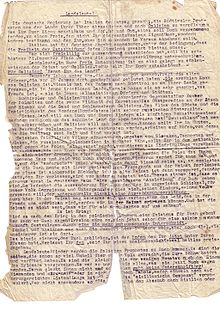- South Tyrol Option Agreement
-
A flyer from the group of German speakers who voted for staying in South Tyrol (Andreas Hofer Bund)

The South Tyrol Option Agreement (German: Option in Südtirol; Italian: Opzioni in Alto Adige) refers to the period between 1939 and 1943, when the native German and Ladin speaking people in South Tyrol and three communes in the province of Belluno were given the "option" of either emigrating to neighboring Nazi Germany (of which Austria was a part after the 1938 Anschluss) or remaining in Fascist Italy and being forcibly integrated into the mainstream Italian culture, losing their language and cultural heritage. Over 80% opted to move to Germany.
Contents
Background
The southern part of Tyrol, renamed "Province of Bolzano", had been a part of Italy since the end of World War I. After the rise of fascism in 1922, a policy of Italianization in the area was implemented ruthlessly. All places, down to the tiniest hamlet, were given Italian names, and even family names were translated. The process intensified in the 1930s, when the government of Benito Mussolini encouraged thousands of southern Italians to relocate to the region, in a deliberate attempt at reducing the indigenous German-speaking population to minority status.
Between 1928 and 1939 various resistance groups formed in the province to fight the fascist Italian regime and its policy of suppressing the German language. Children were taught the prohibited German language in clandestine catacombe schools and Catholic media and associations resisted the forced integration under the protection of the Vatican. The underground resistance movement, the Völkischer Kampfring Südtirols, was formed by a Nazi party member, Peter Hofer.
Option for Germany
On 21 October 1939, Adolf Hitler and Mussolini reached agreement on the assimilation of the ethnic German and Ladin-speaking minorities in the province. The members of these two language communities had until 31 December 1939 to choose between remaining in Italy and losing all minority rights, or emigrating to the Nazi Germany, the so called "Option für Deutschland" (option for Germany).
85%-90% of the population opted for emigration; they were called Optanten and banded together in the Arbeitsgemeinschaft der Optanten für Deutschland (Association of optants for Germany). Those who chose to stay, called Dableiber, mainly banded together around local Catholic priests. The Dableiber were condemned as traitors, while the Optanten were defamed as Nazis. The Option destroyed many families and the development of the economy of the province was set back for many years. The first families left their homeland in 1939, and until 1943 a total of around 75,000 South Tyroleans emigrated, of which 50,000 returned after the war.
The Arbeitsgemeinschaft der Optanten für Deutschland (ADO) (German for "Association of optants for Germany") was an association for German-speakers who had chosen to emigrate to Germany rather than stay in South Tyrol. The association was founded on 30 January 1940. Peter Hofer took leadership of the Association.
German occupation
In September 1943 the Wehrmacht occupied the province and on 10 September 1943 the Operation Zone of the Alpine Foothills was established. The ADO was dissolved and joined with the Deutsche Volksgruppe. Peter Hofer was chosen as the Volksgruppenführer. Some members of the ADO joined with the South Tyrolean Volunteer Corps and were involved in the annihilation of the Jewish population in Meran. They also attempted to arrest fleeing Italian soldiers and attacked those who had chosen to remain, even though this had been expressly forbidden by the Third Reich authority. The relocation of people and the complete Italianization of the area was never fully accomplished.
Aftermath
The majority of the people who had emigrated returned to the area in 1945. Despite Austrian efforts, South Tyrol remained part of Italy after World War II, and many chose to take up Italian citizenship after the Gruber-De Gasperi Agreement. Those who returned had to register themselves and their children, and they had to prove, by means of a birth certificate, that they had the right to Italian citizenship.
After 1945 none of the ADO leaders was tried for their crimes (Peter Hofer was killed by an Allied bombing raid). Only recently have historians started to look in to this dark period in the history of South Tyrol.
According to the 2001 census, more than two-thirds (69.4%) of the population of the province speak German, 26.3% Italian and 4.3% Ladin as their mother language.[1]
See also
- German as a minority language
- Italia irredenta
References
- ^ Oscar Benvenuto (ed.): "South Tyrol in Figures 2008", Provincial Statistics Institute of the Autonomous Province of South Tyrol, Bozen/Bolzano 2007, p. 19, Table 11
Sources
- C. F. Latour: "Germany, Italy and South Tyrol, 1938-45", The Historical Journal, Vol. 8, No. 1 (1965), pp. 95-111
- Klaus Eisterer, Rolf Steininger (ed.): "Die Option. Südtirol zwischen Faschismus und Nationalsozialismus", Innsbrucker Forschungen zur Zeitgeschichte, Vol. 5 (1989), Haymon Verlag, Innsbruck
- Reinhold Messner (ed.): "Die Option. 1939 stimmten 86% der Südtiroler für das Aufgeben ihrer Heimat. Warum?", Serie Piper, ISBN 3-492-12133-0
- Rolf Steininger: "23. Juni 1939 - Gehen oder bleiben? Die Option in Südtirol", Österreich im 20. Jahrhundert, Vol. 2, pp. 217-257
External links
- (German) 23. Juni 1939: Die Vereinbarung über die Umsiedlung, meeting of Himmler and the Italian ambassador in Berlin
- (German) Chronik zur Geschichte Südtirols 1905-1998 Chronology, leaflets since August 1939
- (German) Bevölkerungsentwicklung in Südtirol Population 1940-2000 (PDF)
- (German) Gesellschaft für bedrohte Völker: Option - Anlaß zur Brüderlichkeit Solidarität mit den Opfern heutiger ethnischer Säuberungen 60th anniversary in 1999
Categories:- History of South Tyrol
- History of Austria
- Austria in World War II
- 20th century in Austria
Wikimedia Foundation. 2010.

